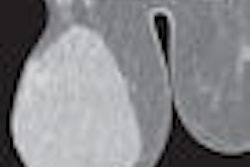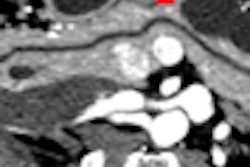Computer-aided detection (CAD) performance is undaunted by low tube current and its accompanying image noise. But CAD sensitivity is harmed by thicker CT slices, which generally increase the number of missed colorectal polyps in virtual colonoscopy (VC or CT colonography), a new study reveals.
Writing in Radiology, Dr. Se Hyung Kim and colleagues from the Seoul National University College of Medicine, Seoul National University Hospital, and Yonsei University Hospital, all in Seoul, Korea, noted that the inconsistencies of VC trial results to date reflect the difficulty of performing VC optimally in the presence of multiple variable factors such as bowel cleansing, colonic insufflation, fecal tagging, scanning parameters, and reader training and experience (Radiology, June 6, 2008).
CAD could potentially overcome many reading difficulties, in particular by improving the reading results of less experienced readers while minimizing interreader variability, they wrote.
While the technical requirements for successful CT colonography (CTC) are becoming established, "the current parameters were selected for human readers and thus might not be optimal for CAD systems," than 3 mm and tube current of 50 to 100 mAs for human readers "might not be optimal for CAD systems," Kim and colleagues suggested. For example, established recommendations regarding section widths smaller than 3 mm and tube current of 50 to 100 mAs for human readers "might not be optimal for CAD systems," they wrote. And many published studies have relied on single- or four-detector-row scanners to test their prototype CAD algorithms.
The study phantoms consisted of 14 colonic segments (90 to 120 cm) from pigs, fitted with 103 polyps (34 flat, 48 sessile, 21 pedunculated) made from small-bowel, stomach, and lymph node tissue from the animals. Sixteen polyps were smaller than 6 mm in diameter, 44 measured 6.0 to 9.9 mm, and 43 were 10 mm or larger, the team wrote.
The researchers scanned the phantoms using a 16-detector-row CT scanner (Sensation 16, Siemens Healthcare, Malvern, PA) at 0.75-mm collimation; 10, 50, 100, and 160 mAs; and a pitch of 1.5, the group wrote. For each mAs setting the images were reconstructed with a section thickness of 1.5 mm and a reconstruction increment of 1.3 mm.
To evaluate the effect of z-axis spatial resolution, CT images were also reconstructed at 100 mAs with several combinations of slice thickness and reconstruction increments (respectively: 1.0 and 0.7 mm, 3.0 and 2.0 mm, 3.0 and 3.0 mm, and 5.0 and 5.0 mm).
The CT data were transferred to a workstation (Leonardo, Siemens Healthcare) equipped with VC and CAD software (Polyp Enhanced View, version VB10A, Siemens Healthcare) that detects polyp candidates from the data.
"The CAD algorithm includes data preprocessing, polyp candidate generation, feature extraction, and classification phases," Kim and colleagues wrote. The features are based on tissue density, volumetric and surface shape, and texture characteristics.
The colon is segmented during the data preprocessing phase, and detections are identified during the polyp candidate generation phase. Each candidate is uniquely identified, and its associated features are fed to a classifier that evaluates and labels the potential polyps. The polyps can then be overlaid on 3D endoluminal and volume-rendered images. Average processing time was about six minutes per dataset.
For the study, CAD performance with the different CT parameters was calculated and compared in terms of per-polyp sensitivity and number of false-positive findings per dataset.
At a constant tube current of 100 mAs, polyp detection was significantly greater in data obtained with section thickness and reconstruction interval combinations of 1.0 and 0.7 mm, respectively (81% [78/96]), and 1.5 and 1.3 mm, respectively (75% [72/96]), compared to those obtained using three thicker slice and reconstruction combinations (27% [26/96] to 64% [61/96]) (p < 0.01), a trend that held steady regardless of polyp size or morphology.
"We did observe higher per-polyp sensitivity for detection of polyps 6.0 to 9.9 mm and polyps 10 mm or larger compared with that for detection of polyps smaller than 6 mm at each tube current setting," they wrote. "However, a significant difference between the size groups was observed at 160 mAs only (p < 0.0062)."
Sensitivity across all tube settings was highest for pedunculated polyps, followed by sessile and flat polyps, and the difference between pedunculated and flat polyps at the three high tube current settings was significant (p < 0.017), the group reported. Sensitivity differences between sessile and pedunculated polyps were not significant at any tube current setting (p > 0.017).
But sensitivity wasn't the whole story. False-positive detections at the thinnest settings (1.0 and 0.7 mm) were also significantly greater (8.9 per dataset) compared to results with thicker sections and reconstruction intervals (4.0 to 6.1 per phantom) (p < 0.05).
At a constant tube current of 100 mAs, CAD missed 15 polyps 6 mm and larger at the thinnest section thickness (1.0 mm) and reconstruction intervals (0.7 mm). Still, most (87% [13/15]) polyps missed by CAD at the thinnest settings were flat.
Surprisingly to the study team, the number of false-negative findings became smaller with decreasing tube current. "The CAD system identified three flat polyps (12, 15, and 19 mm) and two small (3-mm) sessile polyps at only a very low tube current setting (10 mAs)," they wrote.
In detecting flat lesions, differences in CAD's per-polyp sensitivity were significant between only the thickest sections and reconstruction intervals (5 and 5 mm, respectively) and the four other settings (p < 0.002). No flat polyps were detected at this setting. At each setting, per-polyp sensitivity was highest for pedunculated polyps and lowest for flat polyps.
"Given the observed detection performance of CT colonography among the different polyp size groups, the interpretation of our study results is not as simple as we think," Kim and colleagues wrote. "In most CT colonography performance studies involving human readers and CAD, including our current study, investigators reached the consensus conclusion that differences in the rates of detection of polyps larger than 10 mm are not substantial among various combinations of tube current (10 to 150 mAs), pitch (0.75 to 1.50), collimation (0.75 to 5 mm), and scan orientation (0° to 90° C). In contrast, there is a general consensus that CT colonography performs substantially better in the detection of polyps smaller than 5 mm when the images are obtained at thinner sections, normal tube currents, and low pitches."
At the same time, the effects of different scanning parameters on intermediate-sized polyps are still being debated. That and the fact that achieving high sensitivity is such an important goal for CAD, the use of thinner sections and reconstruction increments "should be considered, even at the cost of slightly increased numbers of [false-positive] findings," they wrote.
The authors cited several study limitations, most having to do with the limited numbers, shapes, and sizes of polyps, and the fact that they were manufactured in an animal model ex vivo. But the importance of spatial resolution was clear, they wrote.
"Our data show that CAD performance in polyp detection at CT colonography is highly dependent on z-axis spatial resolution and that tube current does not substantially influence CAD performance at a given z-axis spatial resolution," the team concluded. "Therefore, given the role of CAD as a second-opinion provider, use of thinner [section thicknesses] and [reconstruction intervals] and an ultralow tube current of 10 mAs is strongly recommended for achieving maximal per-polyp detection sensitivity at CAD, with minimal radiation hazard."
By Eric Barnes
AuntMinnie.com staff writer
June 19, 2008
Related Reading
Automated polyp measurement cuts variability, May 21, 2008
VC CAD finds polyps in prepped or unprepped patients, May 6, 2008
Accuracy of polyp measurements depends on CT values, February 21, 2008
VC CAD beats human readers in multicenter trial data, November 19, 2007
Polyp ranking scheme boosts CAD efficiency, October 1, 2007
Copyright © 2008 AuntMinnie.com




















